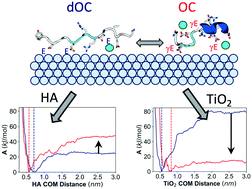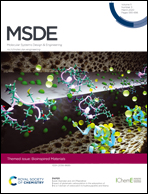Impact of glutamate carboxylation in the adsorption of the α-1 domain of osteocalcin to hydroxyapatite and titania†
Abstract
One proposed mechanism of implant fouling is attributed to the nonspecific adsorption of non-collagenous bone matrix proteins (NCPs) onto a newly implanted interface. With the goal of capturing the fundamental mechanistic and thermodynamic forces that govern changes in these NCP recognition domains as a function of γ-carboxyglutamic acid (Gla) post-translational modification and surface chemistry, we probe the adsorption process of the most commonly occurring NCP, osteocalcin, onto a mineral and metal oxide surface. Here, we apply two enhanced sampling methods to independently probe the effects of post-translational modification and peptide structure on adsorption. First, well-tempered metadynamics was used to capture the binding of acetyl and N-methylamide capped glutamic acid and Gla single amino acids onto crystalline hydroxyapatite and titania model surfaces at physiological pH. Following this, parallel tempering metadynamics in the well-tempered ensemble (PTMetaD-WTE) was used to study adsorption of the α-1 domain of osteocalcin onto hydroxyapatite and titania. Simulations were performed for the α-1 domain of osteocalcin in both its fully decarboxylated (dOC) and fully carboxylated (OC) form. Our simulations find that increased charge density due to carboxylation results in increased interactions at the interface, and stronger adsorption of the single amino acids to both surfaces. Interestingly, the role of Gla in promoting compact and helical structure in the α-1 domain resulted in disparate binding modes at the two surfaces, which is attributed to differences in interfacial water behavior. Overall, this work provides a benchmark for understanding the mechanisms that drive adsorption of Gla-containing mineralizing proteins onto different surface chemistries.

- This article is part of the themed collection: Bioinspired Materials


 Please wait while we load your content...
Please wait while we load your content...
